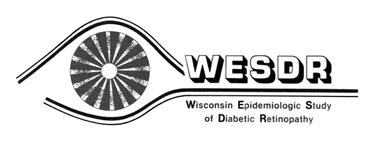THE WISCONSIN EPIDEMIOLOGIC STUDY OF DIABETIC RETINOPATHY (WESDR)
The Wisconsin Epidemiologic Study of Diabetic Retinopathy (WESDR) began in 1979. It was initially funded by the National Eye Institute, part of the National Institutes of Health. The purpose of the WESDR is to describe the frequency and incidence of complications associated with diabetes (eye complications such as diabetic retinopathy and visual loss, kidney complications such as diabetic nephropathy, and amputations), and to identify risk factors (such as poor glycemic control, smoking, and high blood pressure) which may contribute to the development of these complications. Another purpose of the WESDR is to examine health care delivery for people with diabetes.
In previous years of the study, WESDR examinations were done in a large 40-foot mobile examining van in an eleven-county area in southern Wisconsin and involved all persons with younger-onset type 1 diabetes (996 people) and older-onset persons mostly with type 2 diabetes (1370 people) who were first examined from 1980 to 1982. The examinations were done near participants’ residences. The van provided standardized conditions to examine participants and minimized participants’ travel time. The examination involved refraction and measurement of best corrected visual acuity, examination of the front and back of the eye, measurement of the pressure in the eye, fundus photography, blood tests for glycosylated hemoglobin (a measure of recent blood sugar control) and random blood sugar, and urine testing for protein in the urine. The fundus photographs were masked for anonymity and then graded by trained graders. This provided objective information about the presence and severity of diabetic retinopathy (damage of the retinal blood vessels from diabetes) and macular edema (swelling of the center of the retina) in each eye. There were 6 follow-up examinations of the cohort completed in 1984-86, 1990-92, and 1995-96, 2000-01, 2006-07, and 2012-14.
More than 230 reports have arisen from the WESDR which have demonstrated the associations of good control of blood sugar with less risk of incidence and progression of diabetic retinopathy and diabetic kidney disease. Data from the WESDR has been used in developing international guidelines for eye care for people with diabetes. These data have also been used in developing educational programs such as the National Eye Health Education Program. More information about the latter is available from the National Eye Institute.
The National Heart, Lung, and Blood Institute funded the 2000-2001 follow-up of the WESDR cohort to examine the incidence of heart disease and its associations with various risk factors in people with type 1 diabetes. A paper from this study appeared in the Journal of the American Medical Association. This paper showed an association of alcohol with fewer cardiovascular disease deaths in the cohort.
In 2006-2007, follow-up of the WESDR group examined the relationships of novel risk factors such as inflammation and endothelial dysfunction to the incidence and progression of retinopathy and other diabetic complications, and the relationship of these diabetic complications to depression and changes in quality of life in persons with type 1 diabetes.
The seventh examination in 2012-2014 aimed to measure advanced glycation endproducts (AGEs), receptors for AGEs (RAGE), carotid artery intima-media thickness, markers of antioxidant stress, and related candidate genes and their relationships to diabetic retinopathy, diabetic nephropathy, diabetic neuropathy, myocardial infarction, stroke, and cognitive dysfunction outcomes. The study will examine the relationship of retinal blood vessel diameters and severity of diabetic retinopathy to various complications of diabetes. Analyses of the data gathered at this most recent examination are currently underway. The data gathered from the new follow-up examination will provide further opportunity to determine why, independent of glycemic and blood pressure control, and despite long duration of type 1 diabetes, some persons have minimal to mild diabetic retinopathy, nephropathy, neuropathy, cognitive dysfunction, and less severe cardiovascular disease, while others have more severe complications. It is hoped that the new information collected will be useful to patients and their physicians in developing new interventions for managing type 1 diabetes and to public health practitioners charged with delivering preventive care.
